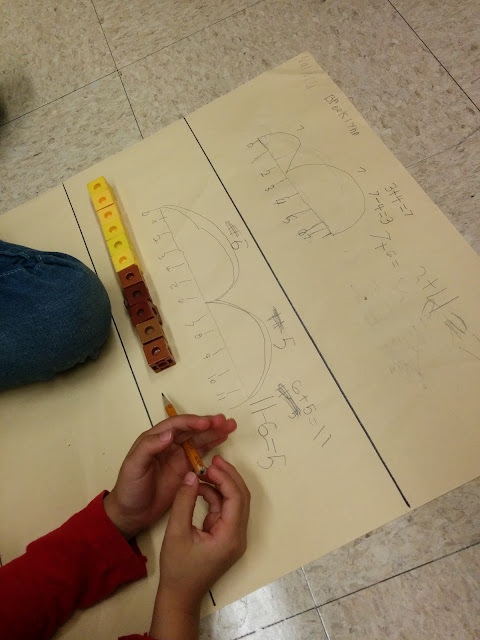The kids drew their families, and labelled their drawings with the French words for mother, father, brother, sister, etc. Next week they will present these to the class and tell about their families.
Our alphabet review covered s and t and we learned gestures for 3 new sounds: v, j and z. We practised reading single syllables that pair these consonants with the vowel sounds, doing our gestures and using funny voices (it makes it more fun!). Our words of the week used "é" and we looked at other letter combinations that make the same sound ("es" in les, des, mes..."er" at the end of action words). I retold the story of Grandmother's Old-fashioned Bed, and the students began supplying parts of the story. We continued to do scaffolded writing on topics chosen by the students.
In math, we began to study number lines. The kids worked in partners and again made a bar of snap cubes with 2 sections in 2 colours. They have already done this a lot, and written the corresponding addition and subtraction sentence with it. This time they traced a line down the side of the bar, added hash marks at each interval between the cubes, and added numbers to the hash marks. Thus, they produced a number line from their bar of snap cubes. I asked them to draw an arc over each section of colour and write the number of coloured cubes on that arc. They also needed to write the addition and subtraction sentence they had illustrated. Each pair of students produced 4 examples. It was hard work, demanding a lot of dexterity in tracing the bar of cubes and lining up the hash marks correctly. By going from the concrete representation (the snap cubes) to the abstract representation (a number line) several times, the students were anchoring their concept of a number line in concrete experience.
We also made a big number line together on the carpet. I gave each student a card with a number from 1 to 20, and called them up out of order to place their number somewhere between 1 and 20. Many kids counted up from 1 to figure out where their number should go, rather than relating it to the other numbers there (like putting a card with 15 to the left of 17 and leaving a space). Activities like this one help them develop awareness of the relationships between the numbers. Once we had our number line built, we did addition with it using a dragon character in puppet form. This grumpy dragon loves adding by jumping, so he would ask the kids for 2 numbers and then he would jump along the line to the count of both numbers and see where he ended up (the sum). The dragon jumps over each card and rests between cards, where the hash marks are on a number line. A common misunderstanding with number lines is failing to realize that each hash mark is counting the space to it's left, that the spaces themselves are what the numbers are counting.
Then we used number lines as a tool to find answers to simple addition questions, and the kids were very impressed with how the number line "gave" them the answer each time!










No comments:
Post a Comment